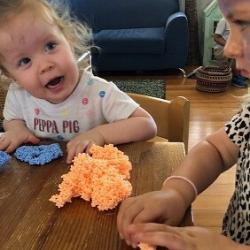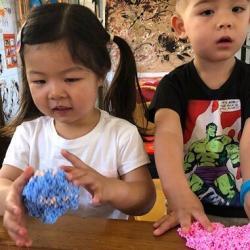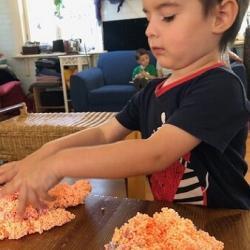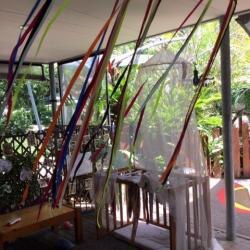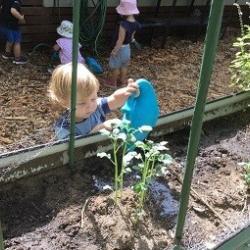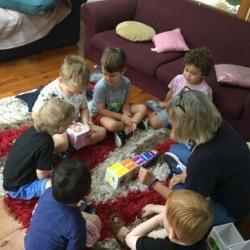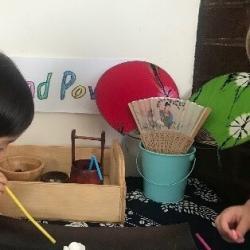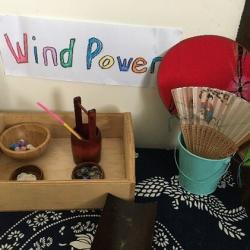Johnson House
The children in Johnson House have been exploring a range of sensory experiences and last week were offered the opportunity to extend these play skills through the exploration of ‘playfoam’. Playfoam’s unusual texture promoted curiosity and questions from the children. At first there was simple exploration of the foam, but as the play progressed the children became more confident and eager to make specific objects with it, ranging from food items to letters. Providing such experiences helps encourage imagination, creativity and increases children’s sensory awareness.
Murray House
Infants
This week in Murray House infants, educator Latha has been following up on children’s interest in sensory play. She made a curtain using vibrant colours of streamers to create a beautiful sensory space for our children. The children were all excited to see the swishing streamers as they ran in between and swished the curtains with their hands to feel. This space is aesthetically inviting and provides sensory stimulation for all of the children in the Murray House. Latha and the team in Murray House infants are working collaboratively to support children’s ongoing learning through sensory play.
Toddlers
This week in Murray House toddlers the children’s learning, development, and wellbeing were actively and intentionally fostered through a range of rich, intentionally planned and spontaneous learning experiences. These included yoga, gardening, fundamental movement skills, literacy experiences and sensory/creative art experiences.
Yoga not only fosters children’s wellbeing, it also offers learning across many developmental domains, for example, following verbal and visual instructions, practicing mindfulness and deep breathing, developing gross motor skills, developing spatial sense and developing regulation skills.
The children have been planting potatoes and sweet potatoes. They used their senses to explore and connect with the natural environment, learned what plants require to grow, and learned to take turns with the spades and watering cans.
Many gross motor activities were facilitated to foster children’s fundamental movement skills such as jumping, stopping/starting while running, kicking a ball and throwing a ball. These skills are the building blocks for more complex skills development and are important physical activities for children to participate in.
Small reading groups and social games were planned and spontaneously facilitated for the children throughout the day. A familiar song called ‘Five Little Speckled Frogs’ was revisited regularly, fostering children’s language, numeracy, and turn taking skills.
This week the children’s creativity and needs for sensory exploration was facilitated through mud play, communal painting, and animal footprints activities.
Robinson House
The children in Robinson House have been developing their awareness and understanding of numbers through the reading and engaging in extended experiences based on the classic picture book ‘The Very Hungry Caterpillar’. After reading the book with educator Cathy, the children have been recalling and retelling the narrative through a variety of experiences. This has included using puppets, arranging nesting boxes with numbers and illustrations of scenes in the book, and writing and illustrating their own story of ‘The Very Hunger Caterpillar’.
Together, the children drew a number line of the fruits the Very Hungry Caterpillar ate – 1 apple, 2 pears, 3 plums, 4 strawberries and 5 oranges. While they have prior knowledge of the number sequence, experiences like this helps them to develop their understanding of numbers and quantity. As they engaged in these experiences, the children were also developing their understanding of healthy eating and the importance of fruit in the diet.
Family Day Care Sydney Wide
The children at Jessie’s Family Day Care Sydney Wide service at St George Sutherland have been learning all about wind power. Jessie was talking to the children about the Lunar New Year so they painted some beautiful cherry blossom trees. To make the branches of the trees they used black paint and then used a straw to blow the paint. The children became really interested in how the paint was moving whilst blowing through a straw and they wanted to know how the paint could move just with air.
To help them explore this further, Jessie set up a wind provocation table using pompoms, shells and glass beads so that the children could experiment with the different objects. One of the children blew on a glass bead but found it was hard to blow, so he used the straw to push the bead along. He then blew on the pompom and could see that it was much easier to move and, he was able to blow all of the pompoms along the tray at the same time, which he was delighted with.
To extend on the children’s interest Jessie has planned to make Wind Mills with them. Science experiences help children to develop vital life-skills such as problem solving, communication and research skills.
